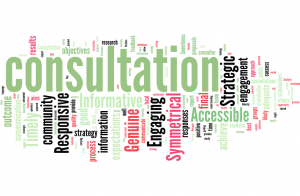All too often, consultation is mentioned in relation to a ‘sham’ or a ‘tick box’ exercise and references made to ‘spin’ and ‘persuasion’.
I have spent some time thinking about standards of excellence in consultation and have come to the conclusion that best practice consultation is all of the following:
Symmetrical
A good consultation aims to achieve a symmetrical flow of information between the consultor and the consultee, as opposed to bombarding the community with information and paying little attention to responses.
Responsive
The day of informing the public on a proposal and collating results at the end of the process is over. Today’s consultations are focussed on ongoing engagement, allowing development proposals to evolve in line with feedback and the process to adapt where necessary.
Positive consultation responses are generated by positive sentiment. An ability to understand what motivates the stakeholder group and to communicate with them in the way in which they feel most comfortable is crucial.
Genuine
Honesty is at the root of all good consultations. Transparency and openness should be present throughout – from setting of realistic objectives, communicating the purpose of the consultation, drawing up agendas for discussion, reporting events and the final feedback. The consultation should focus on excellence in communication and avoid any association with spin.
Information should be shared openly, especially documents which are material to the determination and the results.
Similarly, a consultation outcome should never be pre-determined. Sometimes the outcome will differ from that which was expected, let alone intended. Sometimes factors will come to light which disagree with the outcome. The final consultation report should identify such issues and explain why the final decision did not take them into account.
Engaging
A positive approach is imperative: a quality process will result in a quality outcome. An engaging consultation might mean fun to some stakeholders, inspiration to others, regular and consistent communication others. The consultation strategy must be mindful of the various groups that make up the community and seek to provide relevant and appealing forms of engagement.
A successful consultation is one which results in constructive relationships with the local community. Formal partnerships, such as with potential occupiers of community buildings or with local enterprise groups, are often of substantial benefit, both during the consultation and during the construction phase.
Consultation should be clear on every level, from the language used to the communication of the aims and objectives. A consultation report provides an ideal opportunity to clarify those consulted, the information gained and the impact upon the final scheme.
Timely
Early engagement is good engagement. A consultation should allow ample time to develop the early stages of the strategy, to engage fully and provide adequate time for responses. The timescale of the consultation should be set out in a document which can be accessed by all.
Informative
A consultation is a learning journey: from informative research, to a comprehensive and a well-reasoned conclusion. Consulting bodies should see themselves as learners rather than to teachers, something which should be apparent in their dealings with stakeholders.
Manages expectations
Expectations within a community are likely to be as varied as the individuals that constitute it. This is best tackled through thorough stakeholder research, not only of information but of feelings and expectations. With a greater understanding expectations, both for the consultation and the proposals, the consultor is better placed to communicate the parameters and prevent disappointment. Care needs to be taken to motivate residents to secure their involvement and realistic expectations.
Accessible
The visibility of those carrying out a consultation is a strong indicator of its likely success. Key members of the consultation team, however senior, should be seen to listen and learn.
Strategic
Ultimately, a good consultation must be well researched, based on firm objectives, structured and designed to produce meaningful analysis and evaluation. The strategy should be well understood within the consultation team and communicated to wider audiences clearly, perhaps in the form of a Consultation Mandate. As with all public relations, a strategic approach which conforms to a set of guiding principles is invariably the best route to success.
Additionally, as a member of the Chartered Institute of Public Relations (CIPR), I am committed to abide by the CIPR’s Code of Conduct.
Under the principles of the Code, members of the Chartered Institute of Public Relations agree to:
- Maintain the highest standards of professional endeavour, integrity, confidentiality, financial propriety and personal conduct
- Deal honestly and fairly in business with employers, employees, clients, fellow professionals, other professions and the public
- Respect, in their dealings with other people, the legal and regulatory frameworks and codes of all countries where they practise
- Uphold the reputation of, and do nothing that would bring profession into disrepute
- Respect and abide by this Code and related Notes of Guidance issued by the Chartered Institute of Public Relations and ensure that others who are accountable to me (e.g. subordinates and sub-contractors) do the same
- Encourage professional training and development among members of the profession in order to raise and maintain professional standards generally.
Much of this is common sense, good manners and responsible business practice. But together, I think the Principles and the Code of Conduct address all of the issues which might cause a consultation to be brought into disrepute and as such might be a useful framework for others running public consultations.

